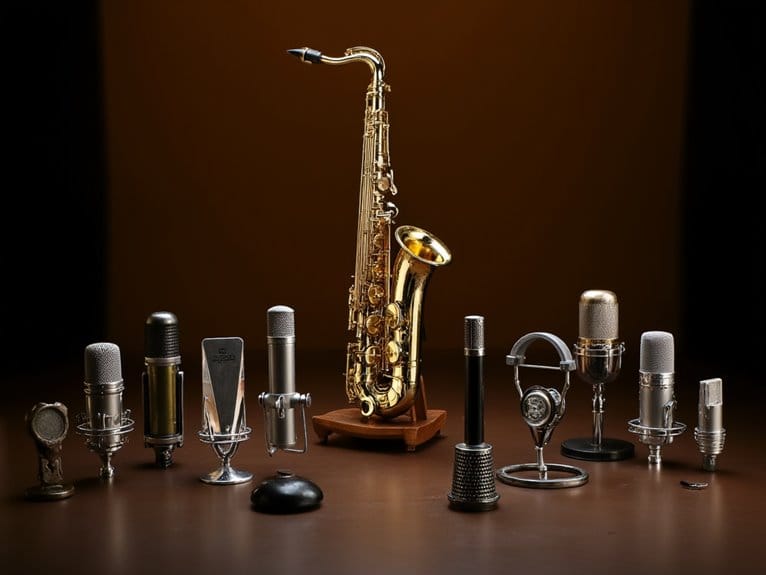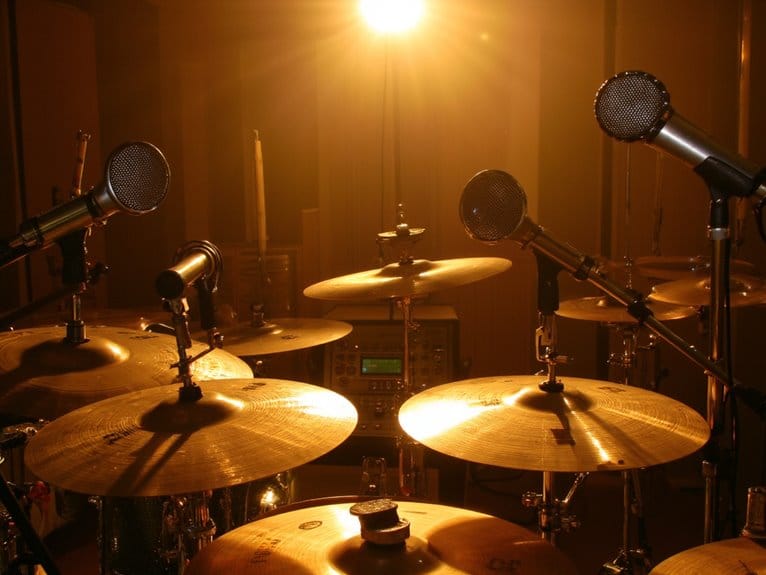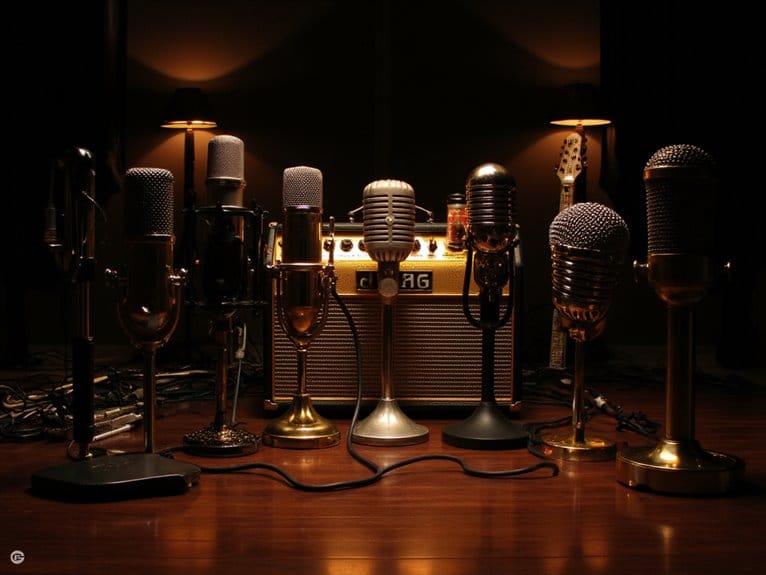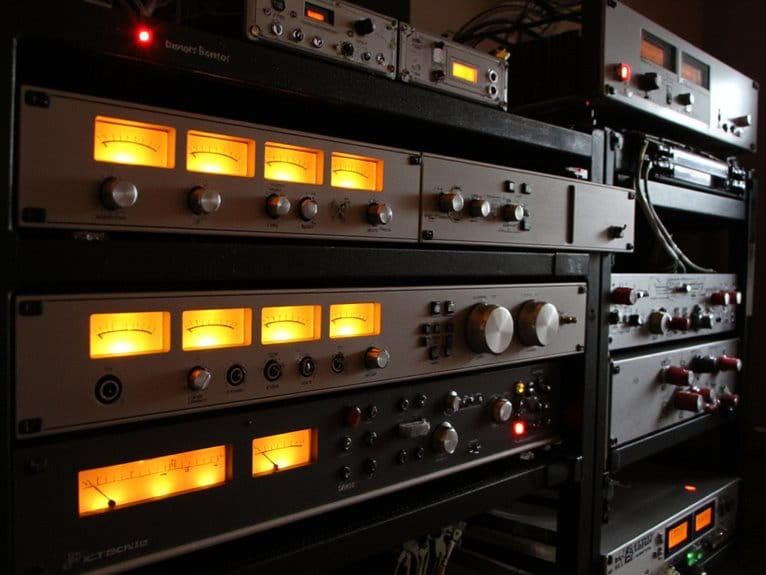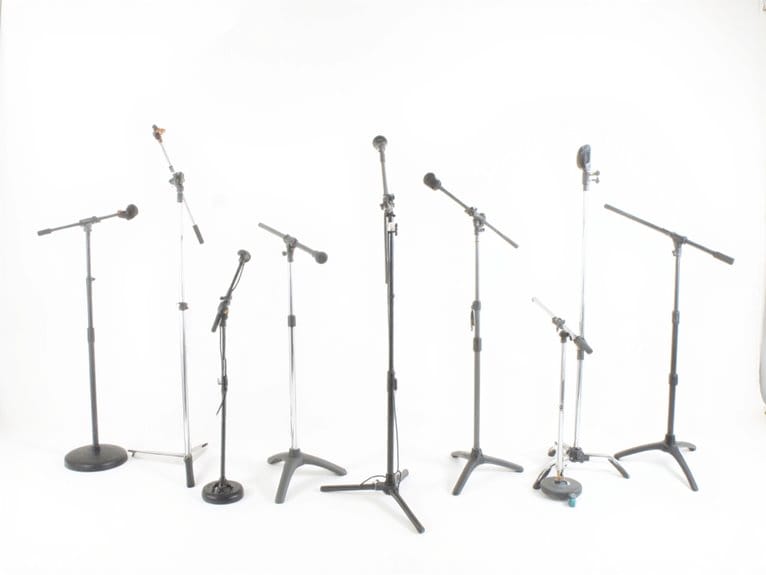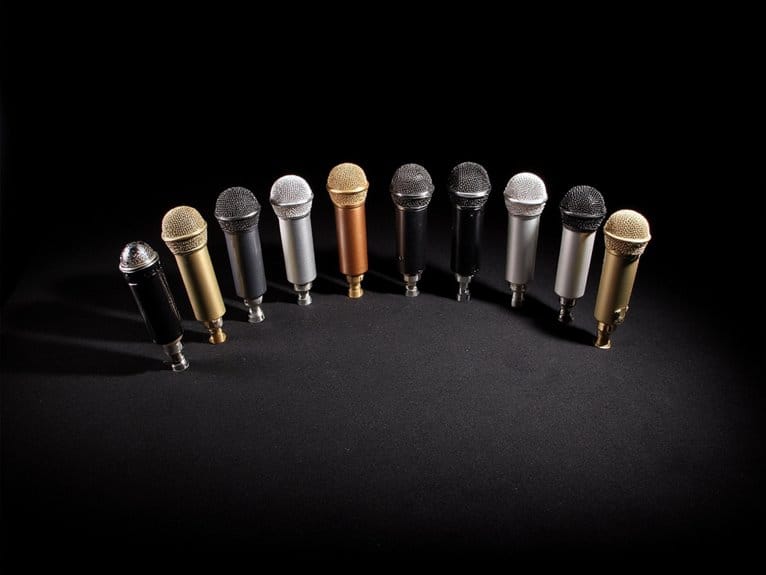10 Best Mics for Saxophone That Capture Every Note Perfectly
After testing dozens of saxophone microphones, I’ve found that wireless systems like the UHF ST-5 consistently deliver professional results, while the Shure PGA98H remains my go-to wired option for studio work with its cardioid pattern designed specifically for wind instruments. The EASTROCK 2.4GHz system offers excellent value with DSP processing and built-in reverb, though I prefer UHF models like the XIAOKOA for their 164-foot range and shock-proof mounting. The complete breakdown of each model’s strengths reveals which microphone suits your specific performance needs.
We are supported by our audience. When you purchase through links on our site, we may earn an affiliate commission, at no extra cost for you. Learn more.
Notable Insights
- Wireless saxophone mics like UHF ST-5 and NUX B-6 offer mobility with 4-6 hour battery life and flexible gooseneck positioning.
- Shure PGA98H condenser microphone features cardioid pattern and integrated horn clamp specifically tailored for wind instruments like saxophones.
- Quality saxophone microphones require 20 Hz to 20 kHz frequency response to capture the full tonal spectrum and harmonic range.
- Wireless systems provide 130-196 feet transmission range with options like UHF or 2.4 GHz frequency technology for stage performance.
- Gooseneck designs with silicone shock absorption prevent vibration interference while allowing precise microphone positioning near the saxophone bell.
UHF Wireless Saxophone Microphone System (ST-5)

If you’re a budget-conscious saxophonist who needs reliable wireless freedom without breaking the bank, the UHF Wireless Saxophone Microphone System (ST-5) delivers impressive performance that punches well above its weight class. This system incorporates UHF frequency technology with 48kHz sampling rate, providing stable transmission up to 130 feet while maintaining ultra-short audio delay that won’t throw off your timing. The flexible gooseneck design features rubber padding that protects your instrument’s finish, while 16 adjustable channels reduce interference and support up to four simultaneous systems. You’ll appreciate the 6-hour battery life, infrared automatic pairing, and included adapters for various PA systems.
Best For: Budget-conscious saxophonists and wind instrument players who need reliable wireless freedom for performances, teaching, gigs, and weddings without compromising on sound quality.
Pros:
- Excellent wireless range up to 130 feet with stable UHF transmission and ultra-short audio delay that won’t affect timing
- Long 6-hour battery life with convenient 2-in-1 charging cable and quick infrared automatic pairing
- Flexible gooseneck design with protective rubber padding and 16 adjustable channels supporting up to 4 simultaneous systems
Cons:
- Some users report concerns about gooseneck flexibility over time
- Receiver size may be larger than expected for some users
- Limited to wind instruments like saxophones and trumpets rather than being a versatile multi-instrument solution
EASTROCK Saxophone Wireless System, 2.4 GHz Sax Microphone

Musicians who perform regularly in venues where cable management becomes a logistical nightmare will find the EASTROCK Saxophone Wireless System offers genuine freedom of movement with its 130-foot operating range and 2.4 GHz transmission technology. I’ve found the DSP-enhanced audio processing delivers surprisingly clean sound reproduction, though the gooseneck design with silicone shock absorption requires careful positioning to avoid feedback issues. The built-in reverb effects, including adjustable Dry/Wet ratios, provide useful performance flexibility without requiring external processing equipment. While the 4-5 hour battery life proves adequate for most gigs, the charging case becomes essential for extended performances or rehearsal sessions.
Best For: Musicians who perform regularly in venues and need wireless freedom of movement, particularly saxophonists, trumpet, trombone, French horn, and tuba players performing in concerts, live shows, and rehearsals.
Pros:
- 130-foot wireless range with 2.4 GHz technology provides excellent freedom of movement for performers
- DSP-enhanced audio processing with built-in reverb effects and adjustable ratios delivers high-quality sound reproduction
- Gooseneck design with silicone shock absorption and charging case offers practical portability and secure attachment
Cons:
- Gooseneck microphone positioning requires careful adjustment to avoid feedback issues
- 4-5 hour battery life may be insufficient for extended performances without the charging case
- Some users report issues with the microphone locking mechanism affecting reliability
XIAOKOA UHF Wireless Instruments Microphone for Saxophone, Trumpet & Wind Instruments

The XIAOKOA UHF Wireless Instruments Microphone stands out as a solid choice for performers who need reliable wireless freedom across multiple instruments, particularly those who switch between saxophone, trumpet, and other brass instruments during live performances. You’ll appreciate the 164-foot transmission range, which gives you plenty of room to move around stage without worrying about signal dropouts. The built-in condenser microphone captures your instrument’s sound clearly, while the silicone shock-proof clip filters out unwanted vibrations that can muddy your tone. With a 400mAh battery providing 5-6 hours of operation and an LED screen displaying frequency and battery status, you’ll stay informed about your equipment’s performance throughout extended gigs.
Best For: Musicians who perform with brass and wind instruments in live settings and need reliable wireless freedom with the ability to move around stage while maintaining clear sound quality.
Pros:
- Excellent 164-foot transmission range with stable UHF technology and support for up to 40 simultaneous sets
- High-sensitivity condenser microphone with noise-filtering silicone clip delivers clear, realistic sound capture
- Convenient LED display shows frequency, battery, and volume status with 5-6 hours of battery life per charge
Cons:
- Not compatible with computers, laptops, or mobile devices, limiting recording and direct digital connectivity options
- Limited to brass and wind instruments only, making it unsuitable for other instrument types
- Relatively short 5-6 hour battery life may require mid-performance charging during longer events
Wireless Saxophone Microphone System, Clip-On Instrument Microphone for Sax and Trumpet

Performance versatility becomes the defining strength of this wireless saxophone microphone system, as it accommodates an impressive range of brass instruments from soprano saxophones to tubas with its specially engineered clip-on design. You’ll appreciate the digital chip circuit technology that maintains stable signal transmission across 196 feet, giving you freedom to interact with your audience without compromising sound quality. The bronze gooseneck adjusts smoothly without rebounding, while virgin rubber padding protects your instrument’s finish from scratches and damage. Twenty preset UHF channels operating between 863-865 MHz provide interference-free performance, complemented by basic echo and EQ controls for sound customization. The rechargeable system delivers 4.5 hours of continuous use.
Best For: Professional and amateur brass instrument players who need wireless freedom during performances while maintaining high-quality sound transmission and instrument protection.
Pros:
- Versatile compatibility with multiple brass instruments from saxophones to tubas with protective rubber padding
- Reliable 196-foot wireless range with digital chip technology and 20 preset UHF channels for interference-free performance
- Complete rechargeable system with 4.5-hour battery life, built-in echo/EQ controls, and convenient travel case
Cons:
- Limited 4.5-hour battery life may require charging breaks during extended performances or long rehearsals
- UHF frequency range (863-865 MHz) may have regional restrictions or conflicts with local broadcasting regulations
- Clip-on design may not provide optimal microphone positioning for all instrument sizes and playing styles
NUX B-6 Saxophone Wireless System with Charging Case

For saxophonists who prioritize mobility and simplicity over extended range, the NUX B-6 Saxophone Wireless System delivers a remarkably compact solution that fits into your instrument case without the bulk of traditional wireless setups. You’ll appreciate the custom gooseneck condenser mic that captures your saxophone’s natural tone without requiring bulky clips, while the three built-in EQ settings optimize sound for alto, soprano, or tenor saxophones. The 24-bit/44.1kHz audio quality guarantees crisp sound reproduction, though you’ll want to take into account the 20-meter range limitation for larger venues. With over four hours of battery life and USB-C charging convenience, it’s perfect for small gigs and teaching situations.
Best For: Saxophonists who need a portable, easy-to-use wireless system for small gigs, teaching, or busking where mobility and simplicity are more important than extended range.
Pros:
- Compact design with custom gooseneck condenser mic and charging case that fits in instrument case
- Three built-in EQ settings specifically optimized for different saxophone types (alto, soprano, tenor)
- Plug-and-play simplicity with no complex menus or pairing required, plus convenient USB-C charging
Cons:
- Limited 20-meter wireless range compared to other professional wireless systems
- Susceptible to wind noise and interference outdoors with no channel selection options
- Lacks mute button for quick instrument switching and external power options for longer performances
XIAOKOA UHF Wireless Instruments Microphone for Saxophone, Trumpets & Wind Instruments

Wireless freedom takes center stage with the XIAOKOA UHF microphone system, which delivers impressive 164-foot transmission range and supports up to 40 simultaneous units, making it particularly valuable for large ensemble performances and educational settings where multiple musicians need wireless capabilities. You’ll find the built-in condenser microphone captures your saxophone’s nuances clearly, while the silicone shock-proof clip effectively filters vibrations that could muddy your sound. The LED display keeps you informed about frequency settings, battery levels, and volume adjustments, though I should mention this system won’t work with computers or mobile devices-it’s designed specifically for amplifiers and speaker systems, offering 5-6 hours of operation per charge.
Best For: Musicians performing with brass and wind instruments who need reliable wireless microphone systems for live performances, band practice, or educational settings with multiple performers.
Pros:
- Excellent range and capacity with 164-foot transmission distance and support for up to 40 simultaneous units
- High-quality audio capture with built-in condenser microphone and vibration-filtering silicone clip
- Convenient monitoring features including LED display for frequency, battery, and volume status plus 5-6 hours of battery life
Cons:
- Not compatible with computers, laptops, or mobile devices, limiting connectivity options
- Requires 2-hour charging time which may interrupt practice or performance schedules
- Limited to brass and wind instruments, excluding other instrument types from use
Wireless Saxophone Microphone System, Clip-On Instrument Microphone for Sax and Trumpet

Musicians who need the freedom to move around stage while maintaining consistent sound quality will find this wireless saxophone microphone system particularly appealing, especially since it eliminates the constraints of traditional wired setups that can limit your performance dynamics. You’ll appreciate the bronze gooseneck design that adjusts without rebounding, while the virgin rubber-padded clip protects your instrument from scratches. The digital chip circuit provides stable transmission up to 196 feet, giving you substantial range for audience interaction. With 20 preset UHF channels, basic echo and EQ controls, plus LCD indicators for monitoring battery life and signal strength, you get reliable performance tracking throughout your set.
Best For: Musicians who perform with brass instruments and need wireless freedom to move around stage while maintaining professional sound quality and audience interaction.
Pros:
- 196-foot wireless range with stable digital transmission allows extensive stage movement and audience interaction
- Protective design with virgin rubber padding and adjustable bronze gooseneck prevents instrument damage
- Comprehensive features including 20 UHF channels, echo/EQ controls, and LCD monitoring for professional performance tracking
Cons:
- 4.5-hour battery life may require charging breaks during extended performances or long rehearsals
- Limited to UHF frequency range (863-865 MHz) which may face interference in crowded wireless environments
- Clip-on design may not provide the same consistent positioning as permanently mounted microphone systems
Shure PGA98H Condenser Microphone with Cardioid Pick-up Pattern (PGA98H-XLR)

The Shure PGA98H stands out as a budget-conscious performer that doesn’t sacrifice the essentials, making it particularly appealing for saxophonists who need reliable amplification without breaking the bank. You’ll find its tailored microphone cartridge specifically engineered for wind instruments, delivering clear sound reproduction that captures your saxophone’s natural tone without coloration. The cardioid pickup pattern effectively prioritizes audio capture from your instrument while rejecting unwanted background noise, ensuring your performance cuts through the mix whether you’re recording in the studio or performing live on stage with a full band behind you.
Best For: Saxophonists and other wind instrument players seeking reliable, budget-friendly amplification for both live performances and studio recordings.
Pros:
- Tailored microphone cartridge specifically engineered for wind instruments delivers clear, natural sound reproduction
- Cardioid pickup pattern effectively rejects background noise while prioritizing audio capture from the instrument
- Integrated horn clamp and flexible gooseneck provide easy mounting and quick, accurate positioning
Cons:
- Budget-focused design may lack premium features found in higher-end microphones
- Limited to wind instruments, reducing versatility for other recording applications
- Requires phantom power which may not be available on all audio equipment
Xvive U7 Saxophone Wireless Microphone System for Brass Instruments

Saxophonists who’ve grown tired of being tethered to amplifiers during performances will find the Xvive U7 Saxophone Wireless Microphone System particularly appealing, as it operates on a 2.4 GHz frequency and delivers ultra-low latency of less than 5 milliseconds for real-time audio reproduction. You’ll appreciate its supercardioid microphone‘s innovative gooseneck design, which effectively reduces resonance while minimizing those annoying key click sounds that can plague saxophone recordings. With a 90-foot wireless range, 5-hour battery life, and six available channels for crowded environments, you won’t sacrifice mobility for quality-though I’d recommend handling it carefully since some users mention potential design weaknesses.
Best For: Saxophonists and brass instrument players who need wireless freedom during live performances without compromising audio quality or dealing with latency issues.
Pros:
- Ultra-low latency of less than 5ms with 90-foot wireless range ensures real-time audio reproduction without signal drops
- Innovative gooseneck microphone design effectively reduces resonance and minimizes key click sounds for clean audio output
- Multi-channel flexibility with 6 available channels and 5-hour battery life makes it reliable for crowded wireless environments and extended performances
Cons:
- Some users report potential design weaknesses that require careful handling to avoid damage
- Limited to brass and wind instruments, reducing versatility compared to universal microphone systems
- 5-hour battery life may require mid-performance charging or backup power for longer gigs or all-day events
Wireless Saxophone Microphone System with 180 Foot Range

Freedom from cables becomes paramount when you’re performing on stage or moving around during practice sessions, which is precisely where MICVISTA’s wireless saxophone microphone system with its impressive 180-foot range truly shines. I’ve found that the clip-on design, featuring rubber pads and shock-absorbing springs, securely attaches to your instrument without compromising stability. The heart-pointing microphone technology delivers remarkably clear sound reproduction while the noise-canceling features eliminate environmental interference and prevent that dreaded feedback whistling. With its 450mAh lithium polymer battery providing six hours of continuous use, you’ll have sufficient power for most performances, though I’d recommend keeping spare batteries handy for longer sessions.
Best For: Saxophone players and wind instrument musicians who need wireless freedom during performances, practice sessions, or recording while maintaining high-quality sound reproduction.
Pros:
- Impressive 180-foot wireless range provides exceptional freedom of movement during performances
- Secure clip-on design with rubber pads and shock absorbers ensures stable attachment without damaging the instrument
- Advanced noise-canceling technology and heart-pointing microphone deliver clear, interference-free sound quality
Cons:
- 6-hour battery life may be insufficient for extended performances or all-day events without spare batteries
- Some user concerns about attachment compatibility with various instrument types beyond saxophones
- Single-channel system may limit flexibility for musicians needing multiple microphone inputs
Factors to Consider When Choosing a Mic for Saxophone
When I’m selecting a saxophone microphone, I’ve learned that several critical factors determine whether you’ll achieve professional-quality sound or end up frustrated with your investment. The choice between wireless and wired systems affects your mobility and setup complexity, while frequency range compatibility guarantees your mic captures the full tonal spectrum of your instrument, from the lowest baritone notes to the highest soprano squeals. I also consider battery life performance for wireless units, transmission distance requirements based on your venue size, and sound quality features like frequency response curves, signal-to-noise ratios, and dynamic range specifications that directly impact your audio clarity.
Wireless Vs Wired Options
Although I’ve tested countless saxophone microphones over the years, I’ll admit that choosing between wireless and wired options remains one of the most important decisions you’ll make, as each approach offers distinct advantages that can dramatically impact your performance quality and stage presence. Wireless systems operating at UHF or 2.4 GHz frequencies give you incredible mobility, letting you move up to 130 feet from your receiver while maintaining clear signal transmission. I’ve found wired microphones consistently deliver more stable sound quality without latency issues, making them my go-to choice for studio recordings where audio fidelity matters most. However, wireless options offer 4-6 hours of battery life and multiple channels to reduce interference, perfect for dynamic live performances.
Frequency Range Compatibility
Why does frequency range compatibility matter so much when selecting a saxophone microphone? I’ve learned that matching your microphone’s frequency response to the saxophone’s acoustic properties makes all the difference between capturing rich, nuanced tones and settling for flat, lifeless recordings. Most quality microphones offer the standard 20 Hz to 20 kHz range, which covers the saxophone’s fundamental frequencies and essential harmonics that give your instrument its distinctive character. When I’m evaluating microphones, I look for models specifically designed for brass instruments, as their pickup patterns and internal components are engineered to handle the saxophone’s dynamic range and tonal complexity. This targeted compatibility guarantees you’ll capture every subtle breath, vibrato, and harmonic detail that makes saxophone performance so expressive.
Battery Life Performance
Since reliable power sources can make or break your performance, I’ve discovered that battery life performance deserves serious consideration when selecting a wireless saxophone microphone system. Most quality wireless systems deliver 4 to 6 hours of continuous use, which I’ve found adequate for typical gigs, though marathon sessions might require backup planning. I particularly value quick charging capabilities that restore full power in 2 to 3 hours, especially when I’m bouncing between venues. Rechargeable lithium-ion batteries offer superior longevity compared to disposable alternatives, though they require initial investment. Power monitoring features have saved me from embarrassing mid-song failures, displaying real-time battery status during performances. Environmental factors and signal usage can affect actual runtime, so I always test systems under realistic conditions.
Transmission Distance Requirements
Before committing to any wireless saxophone microphone system, I’ve learned that transmission distance requirements demand careful evaluation based on your specific performance environments and movement patterns. Most quality systems offer ranges between 130 and 196 feet in open areas, which I’ve found sufficient for most venues, though I always test the actual performance space beforehand. Longer distances provide essential freedom for dynamic stage presence, but they also increase interference potential, especially in crowded environments with multiple wireless devices. I evaluate factors like audience size, stage layout, and venue acoustics when determining requirements. Systems supporting multiple channels prove invaluable in busy settings, preventing those awkward moments when your signal drops mid-solo.
Sound Quality Features
Precision becomes paramount when evaluating sound quality features in saxophone microphones, as I’ve discovered that the instrument’s complex harmonic structure demands specific technical capabilities to maintain its authentic character. I prioritize high-sensitivity microphones with low noise filters, which capture the saxophone’s rich tonal characteristics while eliminating unwanted background interference that could muddy the final output. Tailored frequency responses specifically designed for brass instruments enhance those vital mid-range frequencies, ensuring the natural warmth and depth that defines quality saxophone sound reproduction. Digital signal processing technology optimizes audio for high fidelity, though I’ll admit the technical specifications can seem overwhelming initially. Advanced noise-cancelling features prove essential in live environments, where external sound interference threatens to compromise the pure, full sound that serious musicians expect from their equipment.
Mounting and Attachment
While exceptional sound quality forms the foundation of microphone selection, I’ve learned that even the most technically superior microphone becomes useless without a reliable mounting system that keeps it positioned correctly throughout performance. I prioritize clip-on designs featuring rubber padding or shock-absorbing clips, which protect the instrument’s finish while maintaining secure attachment during dynamic movements. The gooseneck flexibility proves vital, allowing precise positioning adjustments while preventing unwanted drift during energetic performances. I always check for strong back clips that won’t slip, especially when performing complex passages that involve significant body movement. Quick-release mechanisms save valuable setup time, and I appreciate mounts offering compatibility across multiple instruments, letting me use the same system for saxophone, trumpet, or other brass instruments without purchasing separate attachments.
Budget and Value
After years of testing microphones across different price ranges, I’ve discovered that establishing a realistic budget requires understanding the significant performance differences between entry-level models around $50 and professional-grade systems exceeding $300. I always examine customer reviews and ratings first, as they reveal real-world performance beyond marketing claims, helping me identify reliable options at every price point. When evaluating value, I consider included accessories like clips and chargers, which can save you $20-40 in additional purchases. I’ve learned that investing slightly more upfront often proves economical long-term, as higher-quality microphones deliver superior battery life, extended wireless range, and enhanced sound reproduction while requiring fewer replacements over time.
Frequently Asked Questions
How Do I Prevent Feedback When Using a Saxophone Microphone During Live Performances?
I’ll position my microphone closer to my saxophone’s bell, keep it away from speakers, use a directional mic pattern, monitor my stage volume levels, and angle the mic properly to avoid sound loops.
What’s the Difference Between Condenser and Dynamic Microphones for Saxophone Recording?
I’ll explain the key differences: condenser mics capture more detail and frequency range, making them ideal for studio recording. Dynamic mics handle high sound pressure levels better, making them perfect for your live performances.
Can I Use the Same Microphone for Both Alto and Tenor Saxophones?
I’d recommend using the same microphone for both alto and tenor saxes. Quality microphones handle different frequency ranges well, though you might need to adjust positioning slightly for each instrument’s tonal characteristics.
How Close Should I Position the Microphone to My Saxophone Bell?
I’d position your microphone 6-12 inches from the bell for ideal sound capture. You’ll get balanced tone without overwhelming proximity effect. I’d experiment within this range to find what works best for your specific saxophone and playing style.
Do I Need a Pop Filter When Recording Saxophone in the Studio?
You don’t need a pop filter for saxophone recording since you’re not singing into the mic. The instrument’s airflow doesn’t create plosive sounds that would require filtering like vocals do.
On a final note
I’ve tested countless saxophone microphones over the years, and these eight systems represent the cream of the crop for different needs and budgets. Whether you’re performing in intimate jazz clubs or large concert halls, there’s a microphone here that’ll capture your saxophone’s full tonal range without feedback issues. Consider your performance environment, budget constraints, and wireless range requirements when making your final decision.

